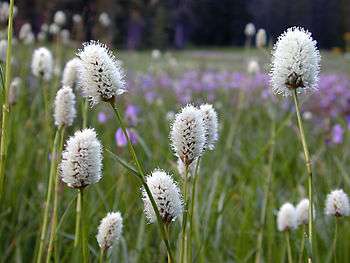Bistorta bistortoides
| Bistorta bistortoides | |
|---|---|
 | |
| Scientific classification | |
| Kingdom: | Plantae |
| (unranked): | Angiosperms |
| (unranked): | Eudicots |
| (unranked): | Core eudicots |
| Order: | Caryophyllales |
| Family: | Polygonaceae |
| Genus: | Bistorta |
| Species: | B. bistortoides |
| Binomial name | |
| Bistorta bistortoides (Pursh) Small 1906 | |
| Synonyms[1] | |
| |
Bistorta bistortoides (American bistort, western bistort, smokeweed or mountain meadow knotweed) is a perennial herb in the genus Polygonum within the buckwheat family.
Bistorta bistortoides is distributed throughout the Mountain West in North America from Alaska and British Columbia south into California and east into the Rocky Mountains.[2][3]
Bistorta bistortoides grows from foothills to above the timberline, although plants growing above 7,500 feet (2250 m) are smaller and seldom reach more than 12 inches (30 cm) in height. Plants in other areas may reach over half a meter-1.5 feet (20-60 cm) tall. The leaves are leathery and up to 40 centimeters (3 feet) long, and are mostly basal on the stem. The dense cylindrical to oblong inflorescence is packed with small white to pinkish flowers, each a few millimeters wide and with protruding stamens.[4]
American bistort was an important food plant used by Native Americans living in the Mountain West, and the roots are edible either raw or fire-roasted with a flavor resembling chestnuts. The seeds can be dried and ground into flour and used to make bread. They were also roasted and eaten as a cracked grain.[5][6]

References
- ↑ Polygonum bistortoides Pursh 1813
- ↑ Biota of North America Program 2014 county distribution map
- ↑ Turner Photographics, Polygonum bistortoides - Wildflowers of the Pacific Northwest photos, description, partial distribution map
- ↑ Flora of North America, Bistorta bistortoides (Pursh) Small, 1906. Western or American bistort , smokeweed
- ↑ Edibility: Identification and edible parts of American Bistort
- ↑ Tilford, G. L. Edible and Medicinal Plants of the West ISBN 0-87842-359-1
External links
| Wikimedia Commons has media related to Category:Bistorta bistortoides. |
- Jepson Manual Treatment - Polygonum bistortoides
- United States Department of Agriculture Plants Profile
- Polygonum bistortoides - Callphotos Photo gallery, University of California